The beauty of life in Roseland is that, as varied as it was, it had happenings that were so dependable as to be practically traditional. That memory endures even in a pandemic world where everyone’s events have been curtailed, cancelled, downplayed, postponed, simplified and placed in a downward spiral. Roseland’s traditions make reminiscing easy. Since this is my October column, we have plenty of events to recall.
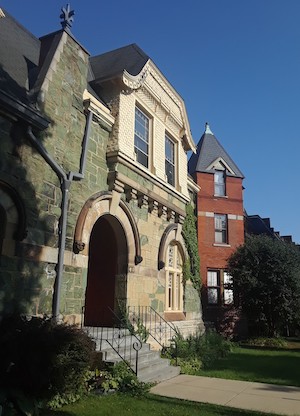 The Pullman House Tour, which has take place every year on Columbus Day weekend for the past 46 years, has been cancelled for the first time ever. I recall when I first bought my house and moved in at 11403 S. St. Lawrence on September 27, 2012, which was too soon (or too late) to get in on the house tour. I did the next best thing and volunteered for that year’s tour.
The Pullman House Tour, which has take place every year on Columbus Day weekend for the past 46 years, has been cancelled for the first time ever. I recall when I first bought my house and moved in at 11403 S. St. Lawrence on September 27, 2012, which was too soon (or too late) to get in on the house tour. I did the next best thing and volunteered for that year’s tour.
In retrospect, my volunteering was a great idea because I got to visit all of the houses on the tour. In addition, there were a few other homes that I got invited into. Seeing the inside of those homes gave me some great decorating ideas. Owners of Pullman houses consider themselves to be custodians of their houses rather than just owner occupants.
Some of the great ideas on display included a second floor with all walls removed and supports added to create one huge room and an atrium leading to the lower level. Another home had the wall along the staircase removed and redefined with a stylized railing. Kitchens were placed in additions to the main house, allowing for dining rooms to be the center of family festivities while keeping the kitchen a casual, informal gathering place.
I put my house on the tour the following October and, looking back, find it hard to believe I had so much zip and zest that year. I accomplished so much with creative interior decorating, painting and designing, posting photos from Italy strategically throughout the house. After eight years, it may be time for a complete overhaul of my decorating efforts. However, now that I’ve retired, I think my get-up-and-go has got up and went!
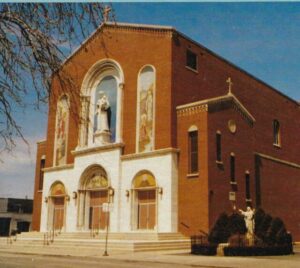 Kensington’s St. Anthony of Padua Parish held its annual dinner dance every year on this same weekend, so for me, it was always hustle through the tour on Saturday in Pullman then head over to the St. Anthony event at the Serbian Social Center in the evening.
Kensington’s St. Anthony of Padua Parish held its annual dinner dance every year on this same weekend, so for me, it was always hustle through the tour on Saturday in Pullman then head over to the St. Anthony event at the Serbian Social Center in the evening.
Interestingly, it was decided not to hold the event last year. However, since so many people missed the event and spoke of how much they had looked forward to it, resurrecting the event was under consideration this year. As a result, there was some planning going on, only for things to come to a screeching halt because of the pandemic. Let us all hope for next year.
The dinner dance was always a reunion for many attendees. With many former parishioners having moved away from the neighborhood, the dinner dance was always a time to renew old friendships. The joke was always “See you at the St. Anthony dinner dance or Panozzo’s,” Panozzo Brothers Funeral Home being another place where impromptu reunions took place. The trouble at Panozzo’s is that the condolences line moves so slowly because of all the mini-reunions going on in the line. The dinner dance was a lot more fun and a lot easier to get around because everybody wasn’t so stiff.
A huge weekend tradition in Roseland, Kensington and Pullman was ciope, ciopa, ciopette! I’ve been told that people who lived in Pullman could smell the scent of the fresh baked bread from Gonnella on Saturdays. It was the signal to start heading to the bakery’s back door to get freshly made, still-hot ciope.
Ciope is a bread unique to the Veneto region and a fond culinary memory for many Roselandites. Sadly, ciope is now only available in that area of Italy. The work involved in creating the proper dough is very intense. The premise with the ciopa dough is that it is continuously kneaded until all the air has been forced out. The resulting dough has a taste that is hard to match and the shape of the bread is elusive.
St. Anthony parishioners would leave Mass and head straight to Gonnella’s or Pannetti’s or Bernardi Brother’s to get their weekly fix. They would then take the bread home to eat with their Sunday family meal. All the air was forced out of the ciope dough in the manufacturing process, which meant that the it would be hard by Monday morning, and used as dunkers with their Italian “café e latte” to start the week.
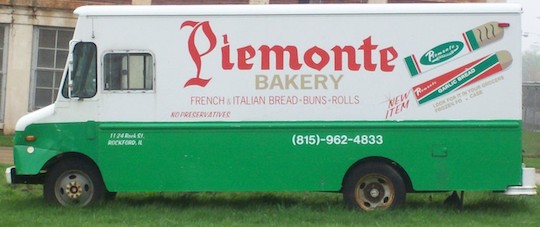 Back in 2009, I began “The Great Ciopa Hunt” on the website Chowhound. Eventually, a few recipes showed up. I also received notice that Piemonte Bakery in Rockford made ciope. I made many trips to see Steve Dodaro, whose great-grandfather started what eventually became Gonnella Bakery. Actually, the bakery on Kensington was billed as the Rockford Piemonte Branch Bakery in Chicago, which begat Torino’s, which begat Gonnella. The Rockford ciope didn’t look like the one we grew up with and didn’t taste like it, according to people who had tried it. I did my best to explain that since there was so little call for ciope, and Steve only served custom orders, the Rockford ciope had to contain some air, which altered the dough’s consistency, but provided for a longer shelf life.
Back in 2009, I began “The Great Ciopa Hunt” on the website Chowhound. Eventually, a few recipes showed up. I also received notice that Piemonte Bakery in Rockford made ciope. I made many trips to see Steve Dodaro, whose great-grandfather started what eventually became Gonnella Bakery. Actually, the bakery on Kensington was billed as the Rockford Piemonte Branch Bakery in Chicago, which begat Torino’s, which begat Gonnella. The Rockford ciope didn’t look like the one we grew up with and didn’t taste like it, according to people who had tried it. I did my best to explain that since there was so little call for ciope, and Steve only served custom orders, the Rockford ciope had to contain some air, which altered the dough’s consistency, but provided for a longer shelf life.
Today, the Piemonte Bakery in Rockford no longer exists. I have heard of a number of people who make ciope, but they haven’t duplicated the shape or taste that we are familiar with. Since my return from Italy this past October, I’ve searched for a proper pizza dough recipe and have found Rhodes Pizza Dough, which can also be used for bread making.
In 2010, choosing one of the many ciope recipes I’ve collected, I tried to make ciope and was dissatisfied with both the taste and the shape. After that, I let the ciope story rest because I had found the Rockford ciope. Fast forward to these days of quarantining. A number of people have asked if I make ciope, as they were attempting to make their own. After much thought, and being put off by the work involved in creating the dough, I decided to skip that step by using the pizza/bread dough I’d found and focused solely on the shape.
Success! By following an assortment of directions that I assembled and photos I found online, I very closely duplicated the ciopa shape of our youth. No, the taste and texture is not the same. However, if you look in the mirror, do you see anything that hasn’t changed in 50 years? I’m including a photo — no, not of me — of my ciope. I will also post a couple of recipes and photos to get you started on the surprise you can present to your family.
To contact me with information or to purchase a copy of my book “Petals from Roseland: Fond Memories of Chicago’s Roseland, Pullman and Kensington Neighborhoods” for $20 + $4 s&h, 11403 S. St. Lawrence Ave., Chicago IL 60628; email: petalsfromroseland@gmail.com; tel res: 773-701-6756. Copies of my book can also be purchased at D & D Foods in Chicago Heights.
CIOPE RECIPES AND PHOTOS
From Margherita Albarello
1000 grams white unbleached flour, sifted
400 ml water
5 grams dry yeast
1 tsp. sea salt
100 ml. olive oil
1 tsp. malt powder
1/2 tsp. honey
Mix 250 grams flour, the yeast, and ½ tsp. honey with all water and work for a few minutes. Cover with plastic wrap and let it rest until it doubles in volume (about 4 hrs.). Add balance of ingredients and work with dough hook, about 10-15 minutes. Cover again and rest until doubled (about 1.5 hrs.).
Divide dough into 16 pieces of 90 grams each. Flatten each piece with pasta machine, set to maximum thickness. Roll each piece to obtain a tube shape, and flatten again. Take the piece (now a strip) and begin to roll it. Make shapes as you wish. This is when, for example, you take two strips and entwine them so that you get the characteristic “knobs.” Let rest, covered, for 40 minutes.
Bake in a 392-degrees oven for 30 minutes with ice cubes in cast iron pan at the bottom of the oven. I put the unbaked cioppe on a pan with parchment paper.
Buon appetito!
Note: This is a work in progress. I must say, my first attempt far exceeded my expectations. It is the rolling out of the dough on a manual pasta machine and the subsequent rolling of the dough into tube shapes that gives the ciope its characteristic airiness and internal layers. Don’t be frustrated and don’t hold back on experimenting. Enjoy, and I hope you share your outcomes with all of us, with pictures, of course!
From Gloria Sliventsky
1-1/2 T dry yeast (or 1/6 cake from 1/2-pound bar of fresh yeast)
3 tbl. sugar
1/2 cup dry milk
3-1/2 cup lukewarm water
1½ sticks of butter, melted and cooled
1-1/2 T salt
14-16 cups flour (or more)
Dissolve yeast in 1 cup lukewarm water. Add pinch sugar and let stand a few minutes. Put 4 cups flour into large bowl. Make a well. Add sugar, dry milk, 2-1/2 cups lukewarm water and yeast mixture. Beat well with wire whip.
Add butter and beat, then salt and beat, then flour and mix to make a very stiff dough. Knead until smooth and elastic, 15-20 minutes. Let rest a few minutes.
Divide into two balls. Place in two greased bowls, turn and cover. Let dough rise for 45 minutes to an hour, punch down, let rise again, and punch down. Make 32 small pieces of dough, 16 per ball. Cover and let rest 10 minutes. Flour board well and shape.
Place on 2 well-floured cookie sheets (do not grease). Let rise again. Bake in a 300-degree oven for 1 hour, exchanging pans at the half hour. Turn off heat. Let stand in oven 15 minutes more. Take out and cool.
From CJ Martello
This is how I formed the dough into the traditional ciope shape.
To skip the dough making process, as I did in order focus on the shape, I found Rhodes Pizza Dough at Mariano’s in a three-loaf package. Any commercial pizza/bread dough will do. Don’t forget to let me know how things turned out for you.
Buona fortuna!
 Fra Noi Embrace Your Inner Italian
Fra Noi Embrace Your Inner Italian


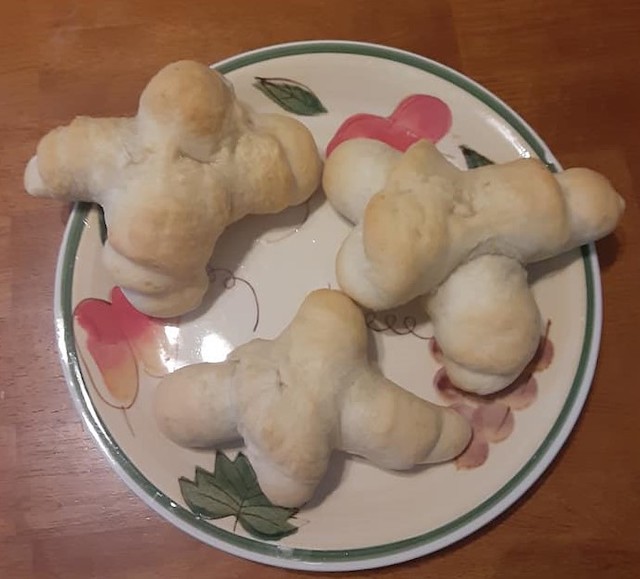
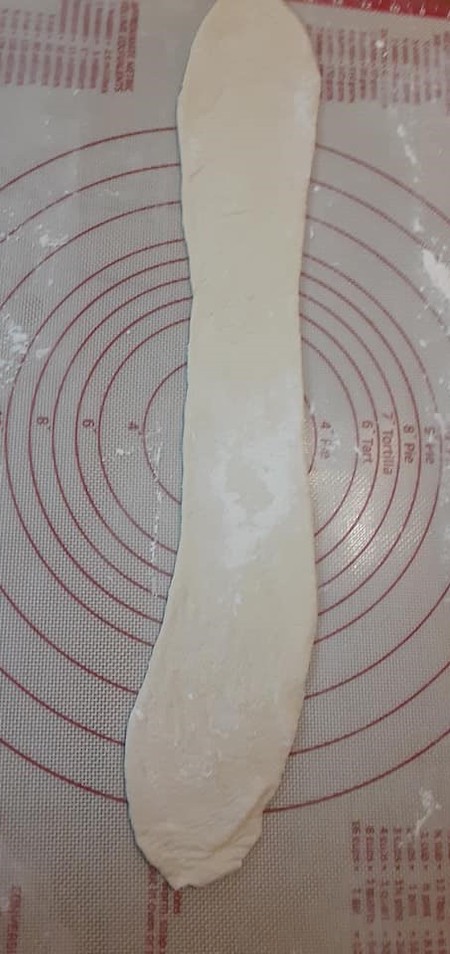
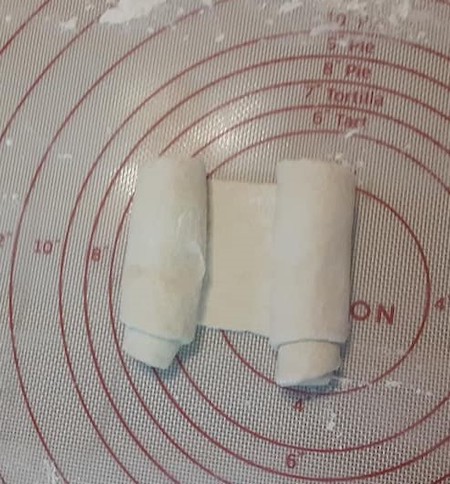
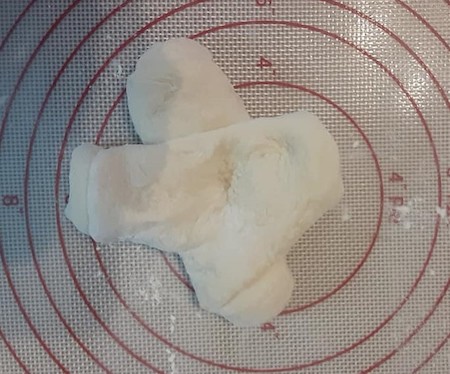
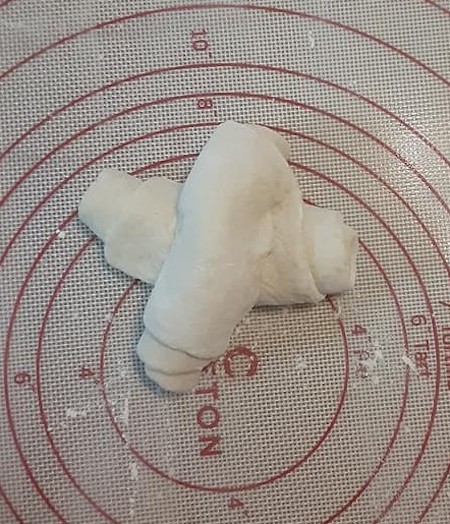





nice ciopa CJ SOME BURRO, YUM. JACK